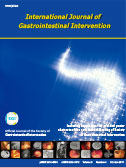
pISSN 2636-0004
eISSN 2636-0012
ABOUT THE IJGII
ARTICLE CATEGORY
ALL ARTICLES
For Contributors
-
POLICY



 pISSN 2636-0004
eISSN 2636-0012
pISSN 2636-0004
eISSN 2636-0012
 All Articles
All Articles
 Articles
Articles

Abstract :
Cited By: 6

Abstract :
Cited By: 3

Abstract :
Cited By: 10

Int J Gastrointest Interv 2023; 12(2): 64-68
https://doi.org/10.18528/ijgii220018
George Zhang  , Hayden Matthews
, Hayden Matthews  , Osanna Wong
, Osanna Wong  , and Dylan Kurda
, and Dylan Kurda 
Int J Gastrointest Interv 2022; 11(3): 143-148
https://doi.org/10.18528/ijgii210021
Soo-Young Na  , Seong Jung Kim
, Seong Jung Kim  , and Hyoun Woo Kang
, and Hyoun Woo Kang 
Int J Gastrointest Interv 2023; 12(3): 105-109
https://doi.org/10.18528/ijgii230002
Shuji Kariya, Shintaro Yamamoto 
 , Miyuki Nakatani
, Miyuki Nakatani  , Yasuyuki Ono
, Yasuyuki Ono  , Takuji Maruyama
, Takuji Maruyama  , and Noboru Tanigawa
, and Noboru Tanigawa 
Int J Gastrointest Interv 2022; 11(4): 186-191
https://doi.org/10.18528/ijgii220052
Jen-Jou Wong  , Srujana Ganti, Damian Mullan, Derek Edwards, and Hans-Ulrich Laasch
, Srujana Ganti, Damian Mullan, Derek Edwards, and Hans-Ulrich Laasch
Int J Gastrointest Interv 2021; 10(1): 12-16
https://doi.org/10.18528/ijgii190013
Thomas G. Morgan  , Tarryn Carlsson
, Tarryn Carlsson  , Eric Loveday
, Eric Loveday  , Neil Collin
, Neil Collin  , Graham Collin
, Graham Collin  , Peter Mezes
, Peter Mezes  , and Anne M. Pullyblank
, and Anne M. Pullyblank 
Int J Gastrointest Interv 2021; 10(1): 17-22
https://doi.org/10.18528/ijgii200018


 pISSN 2636-0004
eISSN 2636-0012
pISSN 2636-0004
eISSN 2636-0012
| TODAY | 92 |
|---|---|
| TOTAL | 233,046 |
© The Society of Gastrointestinal Intervention. Powered by INFOrang Co., Ltd.